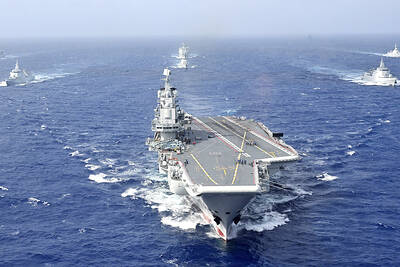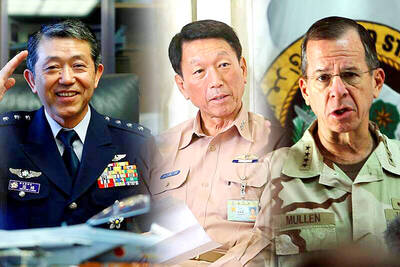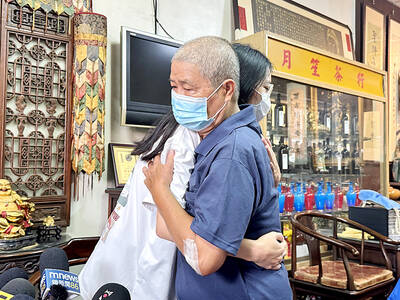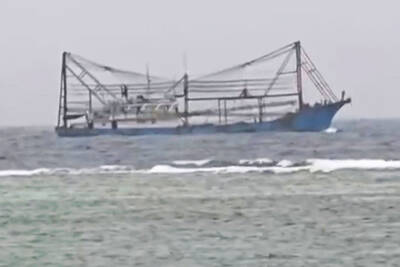Fifty years ago today the KMT, losing China's civil war to the Communists, formally moved to re-establish the capital of the Republic of China on the island of Taiwan.
To say that it has been a tumultuous and eventful half-century would be an understatement. For three-quarters of it, the island was virtually under siege during the Cold War as it provided US forces with an "unsinkable aircraft carrier" against the expansionary threat of communism in East and Southeast Asia. For the remainder, the island has been walking a tightrope in the international community since the US switched recognition to Beijing. And along the way, it has managed to write one of the world's most impressive economic success stories.
It is the stuff of tea houses and bars what might have become of Taiwan had the KMT not moved its headquarters to the island. What did happen, however, can be traced back to one day: Dec. 8, 1949, when the KMT announced the government of the Republic of China was moving to Taiwan.

The relocation was meant to be temporary, as had previous moves from Nanjing to Wuhan, and later to Chongqing on the Chinese mainland during World War II. The KMT had gained control over the island only four years before, after its colonial masters for the previous half-century, the Japanese, were shunted out by the Allied powers at the end of World War II. And Taiwan had until the day of relocation been seen as little more than a source of supplies for the KMT's struggle on the mainland -- a struggle that the party vowed to renew once it had regrouped and reinvigorated itself.
Officially, Taiwan was taken over by the KMT government on Oct. 25, 1945, technically admininstering it on behalf of the victorious Allies of WWII, though in the KMT's eyes regaining Chinese sovereign territory from Japanese occupation forces. There then followed a gradual shift of resources and personnel to Formosa (Taiwan) in what originally was thought to be a regrouping in the KMT's fight against the communists.
But it was not only from the communinsts that the challenge to the legitimacy of the ROC government came. Even before Chiang Kai-shek (蔣?階? and his ragtag team of soldiers and government officials set up camp in Taiwan in 1949, violent clashes had already occurred between those who had been living in Taiwan under Japanese rule and the newly arrived immigrants -- or refugees, as they preferred to think of themselves. The seeds of a bitter enmity between Taiwanese and mainlanders (waishengren, 外省?H) that was to dominate the development of the island's society, its politics and indeed its economy, had been deeply sown.
It did not help that the KMT central government arrived to find that its provincial administration was widely despised by local residents. Most Taiwanese, who had been accustomed to what they saw as much better living conditions and far better government under the Japanese, had grown sick of its incompetency and corruption.
What exacerbated the situation was that there was no outlet for their frustrations. Taiwanese were given no legislative representation whatsoever, and even their places in the government's bureaucracy were being handed over to mainlanders as some 28,000 officials came to the island from China.
The steady rise of ethnic tensions culminated in the 228 Incident, a massacre which began on Feb. 28, 1947, and continued sporadically for several weeks thereafter, in which thousands of people were killed by KMT government troops that had been sent over from the mainland to "restore order."
It was against this backdrop of troubles -- since the KMT set up a provincial government on the island under Chen Yi (
General Chen Cheng (3站? was the provincial governor at the time, having been appointed in January of that year. Shortly after the Dec. 7 announcement of the relocation of the ROC capital to Taiwan, Chen was appointed premier. He was replaced as governor on Dec. 15 by Wu Kuo-chen (吳國楨), a close friend of the Chiang family and former mayor of Shanghai.
Taipei, meanwhile, had experienced a sudden and massive influx of mainlanders. From early 1948 to September, 1949, Taipei's population had risen by almost a quarter, to total 494,000.
Among their numbers were government officials, including more than 350 National Assembly delegates and 300 Legislative Yuan members. All the archives of the five Yuans had already been transferred to Taiwan.
The total number of troops on the island at the time was between 200,000 and 300,000, including the Taiwan Garrison Command, Armoured Corps, Air Force and Navy.
The rich and the ragged
By the time the capital was transferred, a flood of refugees from China had already seeped into every nook and cranny in cities around the island, but mostly in the north. The landscape of urban areas changed dramatically as soldiers in their tens of thousands, many carrying little more than their guns and a cooking pot, and wearing grass slippers, made camp in parks, open areas, temples and schools.
In Taipei, soldiers made camp among the old Japanese tombs in what is now the number 14 and15 parks located at the intersection of Linsen North Rd and Nanjing East Road. Linjiang Flower Park in Panchiao was also a site for many, as were former Japanese military camps. As these rapidly filled, houses nearby the camps were requisitioned for the soldiers.
Yungho, to the southwest of Taipei City, became one of the most popular places for new immigrants to live because it was only a short trip across the Chung Cheng Bridge to the downtown area.
Chang Yan-hsien (張炎憲), now a professor at Academia Sinica who researches Taiwan's history, said: "At the time our school was taken over by soldiers so we could only go to school for half a day.
"We were all very afraid of them; sometimes if you got near to their tents, which were open so you could see inside, they would yell at us and we would run away," Chang said.
A more serious threat, however, were the ten-wheeled military trucks -- "shih lun che" (
"No one would ever get compensated if someone was hit," Chang said.
At the same time there was an influx of rich and influential refugees with their gold bars and luxurious limousines that attracted the attention, wonder and disgust of the locals, even raising adverse comment in the government and party-controlled press. British Consulate correspondence from the period notes that the Taipei Central Daily News described such refugees as "political rubbish" and asserted that "black fury was burning in the hearts of the people", the correspondence wrote.
"The fall of Nanking and Shanghai have had a far-reaching effect on Formosa. Throughout the month of May, party officials and wealthy Chinese continued to arrive ? vast numbers of troops have flooded into the island congesting the ports and occupying all schools and suitable buildings." the British consul noted.
The Taiwanese mood towards these new rulers gradually shifted as time went by, writes Steven Phillips in Taiwan: A New History.
In central Taiwan people talked of "three hopes" there was first hsi-wang (
Struggle: the beginning of silence
As the masses of refugees surging onto Taiwan, prior to the Chiang regime retreating permanently to Taiwan, the government instituted martial law with the help of Provincial Governor, Chen Cheng in May 1949.
In addition to setting an evening curfew, martial law -- which lasted until July 15, 1987 -- banned any form of strike, public expression of political dissent, the spreading of "slanderous information," the carrying of weapons and required all individuals to carry identification at all times.
"No contrasting opinions were allowed," said Lin Yuan-hui (
"If problems could have been discussed openly and consensus was maybe many problems could have been resolved early on."
But the KMT, aware that it was seen by many Taiwanese as an occupying foreign power, was afraid that once it opened up this channel it would overwhelm them, Lin said.
Ironically, British Consulate correspondence in 1949 wrote, Tao Hsi-sheng, one of the Chiang's spokesman, described Formosa as a base for world democracy and resistance against totalitarian aggression and a future link between China's anti-Communist combat and other democratic countries.
However, while the general public was oppressed, there was also internal persecution among the military and the KMT party membership itself.
This continued throughout the 1950s, an era known as the White Terror period.
"On such a small island there were so many troops, so many guns, they could tell you what to think, what to do," and this included not only Taiwanese but mainlanders as well," said Li Hsiao-feng (
Many officials who held positions in the provincial government before the large force of government officials arrived were, beginning in 1949, gradually maneuvered out of their positions.
One well-known case was that of Taiwanese Li Yu-pang (
Li was targeted because of his close connections with the KMT, his wife was jailed for 15 years for suspicion of being part of a communist organization and Li was executed for hiding the secret in 1951.
Li was one of many Taiwanese who early on had made an effort to linking himself closely to the KMT from the time the island's sovereignty was transferred to the Nationalists. These individuals were dubbed ban-shan (
"Those who came later on fought to push those who came earlier out of their positions," Chang said.
When others arrived later and saw the life that other officials were living, and saw that their bowls were empty by comparison they got jealous, Chang said.
"Those who arrived would think to themselves how come it is that these people live in better houses hold better positions, better than those who held central government positions" Chang said.
Freedom overseas?
With the clampdown on freedom of expression, many supporters of Taiwan independence went overseas. However their efforts to save Taiwan from rule under the Nationalist government failed.
"In the end, countries overseas became the new turf for many independence supporters," said Lin Yuan-hui.
Some independence supporters at the time hoped Taiwan would be made a trustee of the United Nations, and administered by the Far Eastern Commission until the true wishes of the people could be determined.
Veteran Taiwanese leader Lin Hsien-tang (
Such arguments while severely repressed never died out completely, however, and became the backbone of the opposition movement in Taiwan.
"It's not really true that all of Taiwanese want independence and that they hate mainlanders, that's not always the case, it's just that the Nationalists let their followers fear Taiwanese," said Lin Yuan-hui.
That fear infects voting to this day, Lin said, adding: "In actuality it was never a question of ethnicity in Taiwan, it was a question of democracy."

A Chinese aircraft carrier group entered Japan’s economic waters over the weekend, before exiting to conduct drills involving fighter jets, the Japanese Ministry of Defense said yesterday. The Liaoning aircraft carrier, two missile destroyers and one fast combat supply ship sailed about 300km southwest of Japan’s easternmost island of Minamitori on Saturday, a ministry statement said. It was the first time a Chinese aircraft carrier had entered that part of Japan’s exclusive economic zone (EEZ), a ministry spokesman said. “We think the Chinese military is trying to improve its operational capability and ability to conduct operations in distant areas,” the spokesman said. China’s growing

Nine retired generals from Taiwan, Japan and the US have been invited to participate in a tabletop exercise hosted by the Taipei School of Economics and Political Science Foundation tomorrow and Wednesday that simulates a potential Chinese invasion of Taiwan in 2030, the foundation said yesterday. The five retired Taiwanese generals would include retired admiral Lee Hsi-min (李喜明), joined by retired US Navy admiral Michael Mullen and former chief of staff of the Japan Self-Defense Forces general Shigeru Iwasaki, it said. The simulation aims to offer strategic insights into regional security and peace in the Taiwan Strait, it added. Foundation chair Huang Huang-hsiung

PUBLIC WARNING: The two students had been tricked into going to Hong Kong for a ‘high-paying’ job, which sent them to a scam center in Cambodia Police warned the public not to trust job advertisements touting high pay abroad following the return of two college students over the weekend who had been trafficked and forced to work at a cyberscam center in Cambodia. The two victims, surnamed Lee (李), 18, and Lin (林), 19, were interviewed by police after landing in Taiwan on Saturday. Taichung’s Chingshui Police Precinct said in a statement yesterday that the two students are good friends, and Lin had suspended her studies after seeing the ad promising good pay to work in Hong Kong. Lee’s grandfather on Thursday reported to police that Lee had sent

A Chinese ship ran aground in stormy weather in shallow waters off a Philippines-controlled island in the disputed South China Sea, prompting Filipino forces to go on alert, Philippine military officials said yesterday. When Philippine forces assessed that the Chinese fishing vessel appeared to have run aground in the shallows east of Thitu Island (Jhongye Island, 中業島) on Saturday due to bad weather, Philippine military and coast guard personnel deployed to provide help, but later saw that the ship had been extricated, Philippine navy regional spokesperson Ellaine Rose Collado said. No other details were immediately available, including if there were injuries among